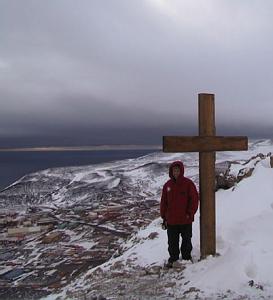
|
|
14 February, 2000
Helicopter top the Palmer
I've had a busy day. I woke up at McMurdo, had a hurried breakfast and got
all my stuff organized, as well as a lot of the equipment we are going to
use for coring, etc. Then we were ferried out to the Nathaniel B. Palmer by
Coast Guard helicopter. I got to ride in the front, skimming through a
notch in the hills, then out over the ice, to land on the ice beside the
ship. Then a crane from the ship lowered a basket type affair which we
hopped onto, and were brought up on deck, fiddle, baggage and all.
I've just come back in from being out on deck watching a scene which I'll
try to describe. We are about a mile or two from the base at McMurdo. There
is a strip of open water near the shore, maybe a quarter of a mile wide. It
is dark blue, almost black with three or four foot waves, spray
occasionally blowing off their tops. It is about 5 degrees and the wind is
blowing at 20 mph.The sky is various shades of gray, about as dark as a
winter evening at three in the afternoon. (It is a little brighter in the
"daytime" i.e. six AM to six PM, but it is light twenty four hours here)
The ice is white and flat, about five feet thick. There are six emperor
penguins a hundred feet or so away on the ice, four lying down and two
standing up, walking around and flapping their flippers. In the background
are the hills of southern Ross Island, gray snow peppered with black rock.
A couple of radar domes and a few antennas are stuck to the tops of the
hills, but how they stay there I don't know. There is snow blowing around
in the air, and three or four inches of it in protected places on the ship.
The hills come and go as low gray clouds obscure the view, or blow clear.
It is a cold and steely gray world.
We've been refueling from a coast guard ice breaker for the last four or
five hours. The Coast Guard Ship had smashed a place up into the ice, maybe
a quarter mile or so, and we followed them in and pulled up beside them,
running a hose between the ships. When all this was done, the ice breaker
pulled forward It actually started from a dead stop into five foot thick
ice. We started maneuvering to turn around and go back out to the open
water. In the process of doing so, the props and thrusters threw big blocks
of broken ice and lighter blue green water up in buckled masses behind the
ship. The ice blocks were the size of four or five cars, just rolled over
and thrown on top of each other by the power of the ship. As we moved
forward, jagged cracks opened and radiated from the ship, blue black lines
on a white background. I was freezing cold but couldn't bear to come in off
the deck, it was such a wild scene.
That's what this place is like. Labrador is wild, but this place is
unearthly. There's so much more I could write but it is late at night here
and I'm getting tired.

Following the Coast Guard icebreaker into the pack. The ice is four or five feet thick. The icebreaker goes right through it. The Nathaniel B. Palmer has a little bit more difficult time, but still can handle it.

I was only in McMurdo overnight, but I at least got a chance to climb Observation Hill.The cross was put up in 1913 in memory of Scott and his companions, who froze to death a couple of hundred miles south of here, after making it to the pole. That's Mcmurdo base at the bottom of the hill, the biggest town in Antarctica.
Contact the TEA in the field at
.
If you cannot connect through your browser, copy the
TEA's e-mail address in the "To:" line of
your favorite e-mail package.
|
